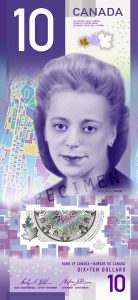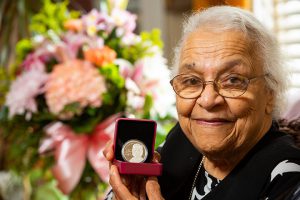A new $20 Fine silver coin honouring Canadian civil rights pioneer Viola Desmond was recently unveiled by the Royal Canadian Mint.
It’s the Mint’s first piece marking Black History Month and features a reproduction of an iconic photograph of Desmond, whose signature is reproduced from a diploma issued by the Desmond Studio of Beauty Culture. Double dates commemorate the year of her birth, 1914, and the year of her death, 1965, while the necklace in the photograph inspired the stylized heart.
“While diversity and respect for civil rights are widely hailed as defining Canadian values, it is important for us to remember that achieving equality in Canada required courageous acts such as Viola Desmond’s defiance of unfair local segregation customs in 1946,” said Jennifer Camelon, interim president and CEO of the Mint.
“Sharing the honest and compelling story of Viola Desmond on our very first coin honouring Black History Month is an excellent way to celebrate an extraordinary Canadian who helped our nation become admired for our cultural diversity and compassion.”
The coin is slated for issue around the 105th anniversary of Desmond’s July 6, 1914 birthdate.
TRAILBLAZING WOMAN
Desmond is perhaps best known for defiantly refusing to leave a “whites-only” area of a movie theatre in 1946; she was subsequently jailed, convicted and fined. The ensuing court case was the first known legal challenge against racial segregation brought forth by a Black woman in Canada.
From her early days as a school teacher, Desmond’s ambition was to start her own hairdressing business; however, there were many barriers, the first of which was finding training. Because beauty schools in Halifax restricted Black women from admission, she travelled to Montreal, New York and New Jersey for various courses. She eventually received a diploma from the renowned Apex College of Beauty Culture and Hairdressing in Atlantic City, N.J.
In 1937, after travelling back to Halifax, Desmond established Vi’s Studio of Beauty Culture, which became a gathering place for women in the community. Within a few years, she established the Desmond School of Beauty Culture and attracted students from across Nova Scotia, New Brunswick and Quebec. She also manufactured and marketed Vi’s Beauty Products, which generated orders from across Nova Scotia.

Desmond also became the first Canadian woman to be portrayed on a regularly circulating Bank of Canada note last year.
DEFENDER OF SOCIAL JUSTICE
On Nov. 8, 1946, Desmond was on a business trip to Sydney, N.S., when her car broke down in New Glasgow. While waiting for repairs, she decided to see a movie at the nearby Roseland Theatre.Unaware of the theatre’s policy of restricting Black people to the upper balcony, Desmond handed the cashier money and asked for “one down please.” The cashier handed her a balcony ticket, but when she entered the theatre, an usher informed her she would need to go upstairs.
Thinking it was a mistake, Desmond returned to the cashier and asked to exchange her ticket.
The cashier refused, stating, “I’m not permitted to sell downstairs tickets to you people.”
Realizing she was being denied because of her race, Desmond courageously walked back inside and took a seat downstairs; however, the theatre manager confronted her and eventually called the police. Desmond was forcibly ejected, arrested, charged and convicted for failure to pay the theatre’s one cent tax, which was required for the downstairs seat.
Desmond was unsuccessful in her efforts to reverse her criminal conviction; however, her story was a milestone human rights case in Canada. Because the case was framed as tax evasion, the real issue of racism was veiled by procedural technicalities. If Desmond had not taken further action, the surviving trial records would’ve left no clue about the true significance of the case: Desmond was denied the downstairs ticket because of her race.
PARDONED IN 2010
On April 15, 2010, Desmond received a posthumous free pardon from the government of Nova Scotia. The pardon was granted by then-Lieutenant Governor of Nova Scotia Mayann Francis, who was the first Black Nova Scotian and only the second Black person in Canada to hold this office. The pardon was accompanied by a public declaration and apology from then-Premier Darrell Dexter, who said no charges should’ve been laid and added Desmond’s conviction was a miscarriage of justice.

An early strike of the coin was presented to Desmond’s sister, Wanda Robson, who said: ‘The engraved details in Viola’s portrait are beautiful, it is so striking. That’s Viola.’
INCLUDES DESMOND’S SIGNATURE
Working with Desmond’s sister, Wanda Robson, and her husband Joe, Mint engravers adapted a famous portrait of Desmond to design the new coin.
“We worked closely with Viola Desmond’s sister, Ms. Wanda Robson, to ensure Viola’s story was shared accurately,” said Matt Eggink, Mint product manager.
The coin’s obverse features the effigy of Queen Elizabeth II by Susanna Blunt.
BLACK HISTORY MONTH
The origins of Black History Month are traced to Harvard-educated Black historian and founder of the Association for the Study of African American Life and History Carter G. Woodson.
In 1926, Woodson – also an author and journalist who spent much of his life Washington, D.C. – proposed setting aside a period of time to honour the accomplishments of Black Americans and raise awareness of Black history. He called it Negro History Week and chose a week in the month of February, which was when both U.S. President Abraham Lincoln and prominent Black social reformer Frederick Douglass were born.
Eventually, the idea was travelled north to Canada, where the first celebration of February as Black History Month was at Toronto’s British Methodist Episcopal Church in 1950 (the church was located at 460 Shaw St. before being lost to fire in April 1998).
In the 1970s, the Ontario Black History Society presented a petition to the City of Toronto to have February officially declared as Black History Month. In 1979, the first-ever declaration of Black History Month in Canada was made by Toronto.
In 1993, the society successfully filed a petition proclaiming February as Black History Month across Ontario.
On Dec. 5, 1995, the House of Commons officially recognized February as Black History Month after a motion was introduced by the first Black Canadian woman elected to Parliament, Jean Augustine, who was the MP for Etobicoke-Lakeshore from 1993-2006.
Canada’s first Black History Month was eventually declared on Feb. 1, 1996.
More recently, in 2008, Senator Donald Oliver moved to have the Senate officially recognize Black History Month, which was unanimously approved.

